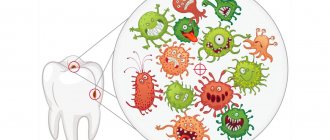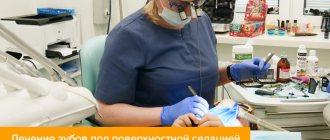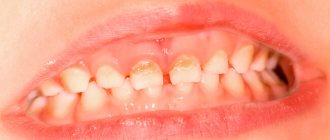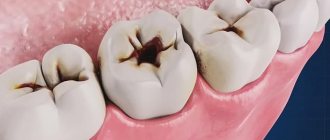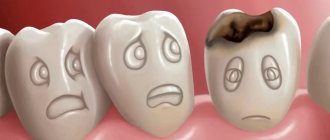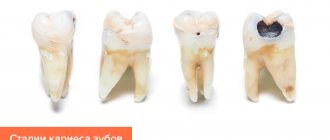Caries is a pathological process characterized by damage to the hard tissues of the tooth and further formation of a cavity in it. In recent years, caries of primary teeth has become a fairly common problem. By the age of 6-7 years, until permanent teeth begin to appear, more than 70% of children have lesions on their baby teeth, and most of them go to the dentist with complications or an advanced process. Most often, caries of primary teeth is detected at 2-3 years of age, but sometimes it can also occur in children who are not yet two years old. In different regions of the country, the prevalence of this form of caries by the age of four is 20-80%. How can such problems be avoided and what do parents need to know?
Causes of caries
Most often, caries of primary teeth can form under the influence of several factors simultaneously. Its most common causes are:
- Damage to tooth germs in the prenatal period. In the embryo, tooth buds begin to form in the first trimester of pregnancy. That is why any illnesses of the expectant mother that she suffered during this period, as well as the use of medications, can contribute to the fact that the fetus’s proper development of teeth is disrupted.
- Insufficient oral hygiene or its absolute absence. In this case, food particles remain on the teeth, and this is an excellent environment for the life and proliferation of bacteria.
- Incorrect eating habits - using pacifiers for a long time. Those children who are unable to switch from drinking from a bottle to a sippy cup or cup for a long time, and especially those who have learned to fall asleep every evening with a bottle or pacifier in their mouth, are at risk of developing bottle caries. With this pathology, through prolonged contact with the teeth of the liquid from the bottle (especially if it is sweet), the front teeth are affected by caries, and the process spreads along the circumference of the crown part of the tooth (along the perimeter of its visible part).
- Insufficient amounts of food in the daily diet, which requires intense chewing and leads to increased salivation, due to which the teeth are cleaned naturally. This factor is inherent in children under two years of age; it is one of the causes of early caries.
- Lack of calcium in food and water - the main building material of teeth and fluorides, which strengthen tooth enamel and protect against caries, preventing the possibility of its development.
- Rickets – with this pathology in children, tooth tissue is easily destroyed.
- Physiologically determined low resistance of children's dental tissue to agents that cause caries.
- Anomalies of dentition and bite.
- Hereditary predisposition.
- Chronic diseases, as well as frequent respiratory diseases, which reduce the overall resistance of the body.
- Excessive amounts of carbohydrates in a child’s food contribute to the development of caries in two ways simultaneously: they feed bacteria, and in the process of their decay, organic acids are formed that damage tooth enamel. For the formation of caries, it is not so much the total amount of carbohydrates consumed that matters, but the frequency of their intake.
Without a doubt, a child who is not yet three years old should not snack between meals, especially food containing a high amount of carbohydrates (sweets, chocolate, etc.). Instead, it is better to offer your baby fruits, marshmallows, marmalade, pastries, and dried goods. It is better to eat sweets after breakfast or dinner, and then brush your teeth after a while. Almost all children do not grow up without sweets, but their consumption should be limited and reasonable.
Bottle caries - what is it and what does the bottle have to do with it?
PHOTO: Bottle tooth caries in a 2-year-old child. Cervical caries of the enamel of the primary incisors of the upper jaw in a 3-year-old child.
Pay attention to the gaps between baby teeth - this is the NORMAL! "Bottle" caries
- caries of primary teeth in the youngest children, usually up to 2 - 3 years of age, occurring against the background of a decrease in the body's defenses, changes in the composition of saliva, disturbances in diet and oral hygiene. “Bottle” caries has many synonyms: “kefir”, “nursery”, “circular” - which reflect the ways and causes of caries and the age at which it usually occurs. As the name suggests, many authors consider the main cause of bottle caries to be an incorrect diet and insufficient oral hygiene in a child.
For my part, I would like to note that in my practice I often encounter children with the most disgusting oral hygiene (or rather, its complete absence), but who, at the same time, do not have carious lesions on their teeth. And vice versa. There are children with ideal hygiene, which has been established since the appearance of the first tooth, but at the same time the child has a mouth full of teeth destroyed by caries. Therefore, I believe that, along with insufficient hygiene, the development of bottle caries is influenced by diet and one’s own specific protective factors in the oral cavity (immunity). This includes the composition of saliva (pH of saliva, microflora in the oral cavity, immunoglobulins contained in saliva, etc.) and its quantity, since during various diseases the secretion of saliva may be disrupted and it may become viscous and thick (viral diseases).
PHOTO: The best prevention of early caries in children is careful oral hygiene. The child is drawn into the game with great pleasure. It is worth using and brushing your teeth in a playful manner, using any situations for this, for example, in the bathroom while bathing.
“Bottle” caries occurs on the 4–6 upper milk teeth: incisors and canines and usually begins in the cervical region of the milk tooth. At first, the enamel in this area becomes porous, like a sponge. Visually, the enamel becomes whitish and rough. Bacteria penetrate the porous enamel and, releasing acids, destroy it. The enamel is destroyed and brownish spots appear. In areas where there is no enamel, bacterial plaque begins to accumulate intensively, aggravating the process.
The Forbidden fruit is sweet…
In order not to tempt your baby with “forbidden fruits,” simply do not buy them or consume them yourself. There is no doubt that your friends and relatives all bring sweets to the child solely with the best intentions. Try to talk to them and explain that instead of candy, you can bring your child, for example, a toy or an interesting book. Due to poor or complete lack of oral hygiene, the plaque that remains on the teeth after eating food turns into dental plaque containing bacteria that produce lactic acid, which damages the enamel and contributes to the development of caries. As soon as a child has his first teeth, he should immediately have age-appropriate toothpaste and a brush. Developing the habit of brushing your teeth at an early age twice a day (in the morning and also in the evening, after meals) will prevent many problems.
Signs of caries
Caries of primary teeth according to the depth of damage can be divided into the following types:
- Initial caries - in this case, white spots of different sizes and shapes appear on the enamel, but there is no pain. If left untreated, the process progresses and the spots darken, become black or brown. If you start timely treatment, you can stop the further development of caries.
- Superficial caries - a defect in dental tissues can be detected exclusively within the enamel. Pain occurs when exposed to sour, sweet, salty foods. A carious cavity can be dark or light. Treatment consists of filling the cavity.
- Medium caries - damage to tooth enamel and part of the dentin (intradental tissue) is detected. Painful sensations arise from hot, cold, salty, sweet. With this type of caries, the cavity is filled.
- Deep caries - the enamel is affected, as well as most of the dentin. When choosing a treatment method, the condition of the pulp is assessed and, depending on whether, filling or conservative treatment is carried out, in which therapeutic pads are used, and then delayed filling.
In children, multiple dental lesions are possible (20 baby teeth may be affected at once). In addition, during childhood, several carious cavities can occur in one tooth. Due to the physiological and anatomical structure of teeth, some children have a thinner layer of dentin and enamel, so hard tissues have a higher permeability, which is why the carious process quickly spreads along the surface of the tooth and deeper. This contributes to the spread of the process to deeper tissues and the development of periodontitis and pulpitis.
Symptoms of caries in children
Signs of the disease depend on its degree. The following stages of caries are distinguished:
- Initial (white or chalky spot stage). White spots indicate areas of enamel demineralization. They look matte in contrast to the rest of the tooth surface, which is shiny. There is no pain or hypersensitivity at this stage, since the pathological process does not affect dentin.
- Superficial. The lesions acquire a dark tint. The enamel is destroyed more severely, and areas of hard tissue are exposed. At this stage, there is increased sensitivity of the tooth to sweet foods.
- Average. Caries covers all layers of enamel, penetrating deeper into dentin. The tooth begins to react painfully to hot and cold food. The pain disappears after eliminating this irritant. Average caries ends with the formation of a so-called hollow - a brown cavity.
- Deep. The carious lesion affects the dentin to almost its entire depth. A thin wall remains between the pathological cavity and the pulp. There is complete or partial destruction of the dental crown. The disease is accompanied by acute pain, not only due to exposure to irritants, but also at rest. In some cases, pain cannot be relieved with analgesics. The tooth may split into several parts.
To detect caries at the first stage, you need to visit the dentist every six months. At the very beginning, the pathology develops asymptomatically, so only a doctor can identify it. A tooth can be treated at almost any stage of disease progression. If left untreated, there is a risk of tooth loss and the development of other oral diseases.
Stay vigilant
If you find plaque forming on your child’s teeth that you are unable to remove on your own, as well as brown or white spots, this indicates that the child urgently needs to be shown to a pediatric dentist. If the baby complains of discomfort that occurs when eating hot or cold food, this indicates the spread of caries into the deeper layers of the tooth. Parents should never ignore such complaints. It happens that a small child is not able to clearly communicate what is bothering him, so if he refuses food or a certain type of food, and also chews on one side, this may indicate toothache.
Complications of caries
The most typical complications of caries are pulpitis and periodontitis.
Pulpitis is a pathological process in which the inflammatory process affects the soft dental tissue (pulp). Symptoms of pulpitis can develop over several hours. This is preceded by minor pain, then acute pain occurs, more often at night or as a result of exposure to temperature stimuli. Such signs indicate that the carious cavity is most likely very deep and the dental pulp is affected. In this case, urgent dental intervention is necessary.
In the event that toothache has been observed repeatedly, the child has swelling of the gums or cheeks, and a fistula with purulent discharge is visible on the mucous membrane near the tooth, pain occurs as a result of biting on the tooth, then this indicates the spread of the pathological process beyond the tooth and inflammatory the process developed in the tissues that surround the tooth and a pathology such as periodontitis arose. When treating it, the doctor will choose the treatment tactics individually, but such a baby tooth is unlikely to be cured and will need to be removed.
Possible treatments for early caries
Since a tooth at the stage of a carious stain does not have a hole, most often initial caries is treated with non-invasive methods. This means that the tooth is not drilled or a filling is installed, the treatment is absolutely painless and is carried out without anesthesia. There are several methods for treating the carious process in the spot stage. The most commonly used are the following:
- Remineralizing therapy.
- Simple and deep fluoridation.
- Infiltration method.
- Fissure sealing.
Let us tell you in more detail what advantages and features each method has.
Methods for treating caries
For caries in children at the initial stage of its development, enamel silvering can be used. In this case, a special solution containing silver ions is applied to the carious cavity (untreated). This is usually a temporary measure used to combat tooth decay. When using silver preparations, areas of the tooth affected by caries, that is, the carious stain itself, are persistently painted black, and this does not look very aesthetically pleasing. However, you don’t need to think that the entire tooth will turn black. Only the part affected by caries will darken, while the healthy part will remain unchanged white.
The most traditional methods of treating caries in primary teeth are removing the affected dental tissue with a drill using local anesthesia. The dentist decides on the need to use local or general anesthesia (anesthesia) individually in each case. Sometimes neither parents nor a doctor can persuade a child to open his mouth in order to treat or show his teeth. Most often, children under three years of age or those suffering from concomitant pathologies face this problem. Then it becomes necessary to treat teeth under general anesthesia. A child should not have any fear of the dentist. It is advisable that he become friends with him and understand that it is necessary to treat his teeth. After all, he will have to deal with this for the rest of his life. The child’s psychological mood largely depends on his parents and loved ones, who can convey to him their fear of visiting the dentist. Try to explain to your child the importance of a visit to the dentist and convince him that there is no need to be afraid of such a procedure.
Why is caries dangerous for a child?
For some reason, many parents believe that it is not at all necessary to treat caries in a child - after all, it will not last long anyway and the teeth will fall out on their own. This is a huge misconception.
Untreated caries can be dangerous for many reasons:
- A child may get a complication in the form of pulpitis - inflammation of the pulp (neurovascular bundle of the tooth). Yes, there is also pulp in baby teeth, with all the ensuing troubles - pain, fever, purulent complications.
- A child can lose a tooth early (sometimes this happens before the age of 3-4), and this will certainly provoke problems with permanent teeth and bite. Teeth may grow beyond the dentition or not erupt at all, resulting in an abnormal bite.
- Deep caries can damage the rudiments of permanent teeth, and the teeth will erupt already sick or not erupt at all. Caries of primary teeth can even be the cause of partial adentia, i.e. the absence of some teeth in the permanent dentition.
Considering that many treatment methods, especially early caries, in a child do not require tooth preparation, you need to consult a doctor as early as possible. This way you guarantee your child healthy teeth for life.
How to brush your teeth?
Each specialist has his own opinion about when to brush a child’s teeth using toothpaste. The composition of the toothpaste must correspond to the age of the baby - all information about this can be found on the packaging. Toothpastes for children under three years of age should not contain fluoride. Children at this age, not having the skills to rinse, swallow the paste. If a large amount of paste containing fluoride enters a child's body, serious health problems may arise, so in this case you should consult a doctor immediately. Children from about 4 years of age after brushing their teeth can partially spit out the remaining toothpaste. This is why toothpastes for this age contain fluorides. The maturation of tooth enamel is accelerated if hygiene products containing active fluoride are regularly used. This has been proven to help reduce the risk of tooth decay.
Children's toothbrushes are varied. For very small children, you can use special finger brushes, with which mother can easily remove plaque from her child’s teeth. By the age of 2.5-3 years, you gradually need to give the child a toothbrush in his hand and teach him to brush his teeth on his own.
Choose a toothbrush with soft bristles, the width of which corresponds to 2-3 teeth. It is recommended to change it every month, because frayed bristles can hurt your gums and are also a source of bacteria. The child should have an individual toothbrush; it should be stored separately, without a case, with the bristles facing up. Before brushing your teeth, as well as after the procedure, the brush should be rinsed well with running water. Oral care with additional hygiene products
- You can use dental floss or floss when all 20 baby teeth have erupted (most often at the age of 2-2.5 years). Dental floss should be used if the teeth fit tightly together. This must be done very carefully so as not to accidentally injure the gums.
- Dental rinses (elixirs) can be used as an additional hygiene product for children with a high risk of developing caries. Special children's elixirs contain fluoride in the amount that a child of a given age needs. You can use it twice a day after brushing your teeth or eating foods that contain a lot of sugar. Chewing gum should not be given to children until after 3 years of age. The sweeteners they contain (sorbitol, xylitol, etc.) have a beneficial effect on tooth enamel and prevent the occurrence of caries. Chewing gum also promotes increased salivation and self-cleaning of the oral cavity. They can be given to children regardless of the presence or absence of a filling in the mouth. Chewing duration is no more than 10-15 minutes.
Prevention of childhood caries
| Prevention begins with proper nutrition of the child - you need to remove all sugar-containing foods in the evening, you need to saturate the child's diet with milk, cheese, cottage cheese, which are rich in calcium and phosphorus, and vitamins for teeth - D, C, A, B and fluoride. We must not forget the importance of solid food. And, of course, one of the most important stages in preventing the development of caries in baby teeth is proper oral hygiene. Our doctors will tell parents and the little patient how to properly care for their teeth. |
How to brush your teeth correctly?
It happens that trying to brush your teeth can sometimes cause a negative reaction. But you don't need to get upset about it. Better be patient and play. Remember that a child under three years of age, and older children too, learn about the world through play. Therefore, do not insist on brushing your teeth; it is unlikely that the baby will understand that this is important. Just play. For such games, a battery-powered brush and a toy on the handle are perfect. The movements performed by the brush for different groups of teeth should differ from each other. Cleaning the front teeth should be done from the gums with unidirectional vertical movements. Move the brush behind the cheeks in a circular manner, while the teeth should be closed. Cleaning the chewing surface of the teeth is carried out with horizontal movements from the inside (from the palate and tongue), back and forth, sweeping upward like a “broom”. But not only the movements that are performed are important, but also how much time is devoted to it. There are two ways to check whether your teeth are being brushed adequately:
- – in terms of time (you need to spend about 7-10 minutes brushing all your teeth), for this you can use an hourglass or any other clock
- – by the number of movements (for each area occupied by the bristles of the brush, 5-6 movements are needed).
Proper nutrition
One of the preventive measures for dental diseases is a balanced diet - one in which the daily diet contains proteins, carbohydrates, fats, minerals and vitamins that are necessary for the formation and proper growth of dental tissues. In infants, this is breastfeeding. Older children need to include in their diet all the necessary types of complementary foods that are recommended for this age. Additional sources of fluoride can also be water and fluoridated salt; their use does not require special indications. The main sources of calcium are fermented milk products (cottage cheese, milk, cheese, etc.), buckwheat, gooseberries, potatoes, peas, oats, mineral water (some of its types).
First visit to the dentist
A child’s first visit to the dentist is most often necessary for the following reasons: for a preventive examination upon admission to a preschool or if complaints arise. Don't wait until after the age of four to visit the dentist for the first time. Subsequently, the child needs such visits twice a year. If the baby has already begun the carious process, then during this time it will not be able to spread deeply, caries complications such as periodontitis and pulpitis will not arise, and the tooth can be saved. The sooner the doctor can detect caries, the more successful and painless the treatment will be. Sometimes, in the initial stages of superficial caries, treatment can be carried out without instrumental intervention using mineralizing agents. In this case, medicinal solutions of calcium and phosphorus are applied to damaged areas of enamel. The dentist’s task is not only to provide dental treatment, but also preventive measures that will help keep teeth and gums healthy:
- professional oral hygiene (removal of dental plaque);
- treatment of teeth with calcium and fluoride preparations
- prescribing general treatment if necessary (internal intake of vitamin and mineral complexes);
- teaching your child how to properly brush their teeth;
- correction of the composition and diet, identification of bad habits together with parents;
- sealing fissures (grooves that are located on the chewing surface of the tooth) is a prevention method that is aimed at preventing caries from affecting permanent teeth.
Silvering of teeth.
PHOTO: Silvering of baby teeth in children. The teeth turned black, but caries did not stop its development. Teeth after repeated silvering. The teeth turned black, but the carious process did not stop, since bacterial plaque continues to accumulate in the carious cavities.
One of the oldest methods of prevention and treatment of the initial stage of caries (in the stain stage) is silvering of teeth. Yes Yes. It consists of sealing, or more precisely, infiltrating, porous enamel with silver salts. The silver nitrate included in the solution, settling on the surface of the enamel, firmly seals the porous areas of the enamel, impregnating them deeply, preventing further penetration of new bacteria and their metabolic products into the enamel. Bacteria located in the pores die, since silver nitrate has a bactericidal effect. Over time, the silver nitrate film requires renewal, so this procedure must be repeated at least every month. Otherwise, the carious process will begin to progress under the silver. A significant disadvantage of silvering is the need to constantly repeat the procedure. After silvering, teeth become black, which makes it impossible to timely diagnose the progression of caries. At the BabySmile Clinic, we abandoned teeth silvering due to the low effectiveness of this technique.
EVEN IF THE SILVER PLATING METHOD IS CORRECTLY PERFORMED AND ALL THE DOCTOR'S RECOMMENDATIONS ARE FOLLOWED, THERE IS NO CHANCE THAT CARIES WILL NOT CONTINUE TO PROGRESS UNDER THE SILVER FILM! SINCE TEETH BLACKEN AFTER SILVERING, THE DEVELOPMENT OF CARIES MAY REMAIN UNNOTEED FOR A LONG TIME.
The advantage of the method is its extreme simplicity, allowing it to be carried out even by the smallest children! The technique of silvering teeth is obsolete, due to the impossibility of guaranteeing any result.


